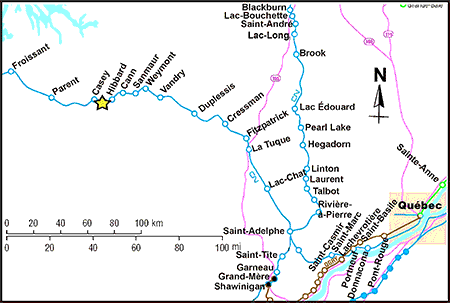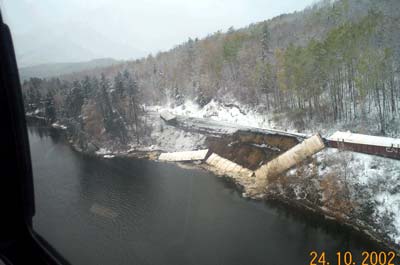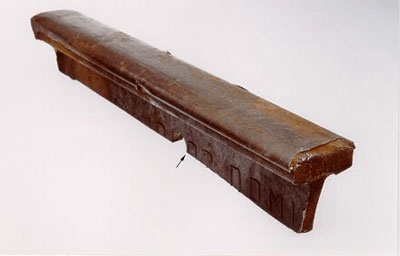Main-track derailment
Canadian National
Train M-366-31-22
Mile 86.43, Saint-Maurice Subdivision
Hibbard, Quebec
The Transportation Safety Board of Canada (TSB) investigated this occurrence for the purpose of advancing transportation safety. It is not the function of the Board to assign fault or determine civil or criminal liability. This report is not created for use in the context of legal, disciplinary or other proceedings. See Ownership and use of content. Masculine pronouns and position titles may be used to signify all genders to comply with the Canadian Transportation Accident Investigation and Safety Board Act (S.C. 1989, c. 3).
Summary
On 24 October 2002, at approximately 0030 eastern standard time, westbound Canadian National train M-366-31-22, en route to Senneterre, Quebec, derailed six cars at Mile 86.43 of the Saint-Maurice Subdivision near Hibbard, Quebec. Six cars were damaged and 275 metres of track was destroyed. There were no injuries and no permanent environmental damage.
Ce rapport est également disponible en français.
Factual information
Canadian National (CN) train M-366-31-22 departed Garneau, Quebec, with 3 locomotives and 109 cars, including 34 loaded cars and 75 empties. It was approximately 6730 feet long and weighed about 7230 tons. The train crew consisted of a locomotive engineer and a conductor. Both were qualified for their positions and met rest and fitness requirements.
At Mile 86.43, near Hibbard, Quebec, (see Figure 1) the train experienced an undesired emergency brake application. The train crew followed the emergency procedures. The conductor inspected the tail end and found that 6 cars (102nd to 107th cars) loaded with copper ore had derailed when coming out of a left-hand curve in the direction of movement. The weather was cloudy, it was snowing lightly, and the temperature was -1°C.
The data from the event recorder on the lead locomotive showed that the train was travelling at 34 mph and that the throttle was moved gradually from the No. 7 position to the neutral position. The emergency brake application was initiated from the train.
The Saint-Maurice Subdivision extends 257.2 miles from Fitzpatrick, Quebec, to Senneterre, Quebec. Train movements are governed by the Occupancy Control System (OCS) in accordance with the Canadian Rail Operating Rules (CROR), and are supervised by a rail traffic controller based in Montréal, Quebec. The main track consists of a single track running east and west. In the accident area, the track is Class 3 according to Transport Canada's Railway Track Safety Rules (TSR), and the maximum speed is 50 mph for passenger trains and 40 mph for freight trains. The maximum authorized car weight is 286 000 pounds and the annual tonnage is approximately 6.7 million tons.
The lead locomotive stopped at Mile 87.58. The first derailed car (102nd car), gondola car CN 137187, remained upright and coupled to the forward portion of the train. The next five cars uncoupled, and three of them descended the track embankment and came to rest at the edge of the lake beside the track (see Photo 1). The derailed cars were damaged and 275 m of track was destroyed. A dike was set up around the derailed cars to recover the ore and clean up the accident site.
The track consists mainly of 100-pound continuous welded rail (CWR). There are 3200 ties per mile of track. The tie plates are double-shouldered and secured with four spikes per tie. The rail is box-anchored every third tie. The ties in the area of the derailment are in good condition.
Track geometry is checked three times a year by the track geometry car, and the rails are ultrasonically inspected for internal defects twice a year. The last rail inspection was done on 11 June 2002, and no defects were found. No rail defects were found on the last bi-weekly inspection done by the track supervisor in a Hi-rail vehicle on 22 October 2002.
At about Mile 86.43, where the track destruction started, the south rail was broken under the last derailed car. No wheel flange or dragging equipment marks were found east of the broken rail. Examination of the cars revealed no mechanical deficiencies before the accident, and no jarring or abnormal movement was felt when the locomotives went over this spot.
The south rail was a partly worn rail. It was jointed, rolled in 1975 and laid in the Turcot intermodal yard in Montréal. The rail was lifted when the Turcot Yard was shut down, and on 02 September 2002, it was laid in the curve from Mile 86.27 to Mile 86.44 over a length of about 1100 feet. The accumulated tonnage on the rail is not known since that information was not recorded for the track from which the rail was taken.
Standard Practice Circular (SPC) 1303, entitled Classification of Rail, which was in effect in 2002, required that partly worn rails be classified and ultrasonically inspected for internal defects. SPC 1303 required that rails with rail end batter or other defects be sawn and bolt holes removed. Accordingly, the rail was checked by the ultrasonic rail inspection vehicle on 16 July 2002, a few days before the Turcot Yard was closed. However, the rails with splice bar bolt holes were not sawn when the yard was dismantled or when the rail was laid in the curve at Mile 86.43, but there was a plan to correct this defect.
The rail was laid, adjusted to length and destressed in accordance with CN's SPCs and recommended practices. The rail length was adjusted for the local preferred rail laying temperature of 32°C (90°F).
Pieces of the south rail were recovered and sent to the TSB Engineering Laboratory for analysis. Examination of the rail (report LP 107/02) indicated that rail wear was within the maximum allowable for 100-pound rail under CN's SPC. The composition, microstructure, hardness and properties of the rail were consistent with standard carbon rail.
The first piece of rail had a longitudinal fracture in the web running through an old splice bar bolt hole drilled through the rail web and intersecting the “0” of the rail markings (see Photo 2). The hole showed no abnormal wear or ovalization, and its edges were not chamfered. Metallurgical analysis of one section taken from the edge of the hole revealed decarburization of the metal surface. The fracture surface was relatively flat and uniform. It revealed grain deformation and sub-surface cracking consistent with long-term pounding wear.
The second piece of rail was found to have a vertical fracture and a longitudinal fracture, which was a continuation of the fracture observed in the first piece. The longitudinal fracture was flat and free of chevron markings, consistent with progressive cracking. The surface of the vertical fracture had chevron markings pointing towards the middle of the web. There was little damage due to wheel pounding on the head fracture surfaces.
Analysis
No wheel flange or dragging equipment marks were found on the track or platform before the point where destruction of the track started. Examination of the cars revealed no mechanical defects before the accident, and the event recorder indicated no abnormal train manoeuvres. Consequently, the analysis will focus on the failed rail.
Laboratory testing revealed that cracks originated on either side of the splice bar bolt hole and propagated longitudinally through the rail web. Decarburization of the rail around the splice bar bolt hole indicates that heat was applied to the metal during the hole drilling process. Further, the splice bar bolt hole intersected the rail markings, and the edges of the hole were not chamfered. Consequently, the hole presented a site for mechanical and metallurgical stress raisers and contributed to the initiation and propagation of cracks.
Since not much wheel pounding damage was observed on the head fracture surfaces and the train crew felt no jarring or abnormal movement as the locomotives travelled through Mile 86.43, it was determined that the vertical fracture was very recent. The chevron markings observed on the vertical fracture surface are consistent with instantaneous failure in overstress. The direction of the chevrons indicates that the fracture originated in the middle of the web, where the pre-existing longitudinal crack was located. Once initiated, the vertical fracture occurred rapidly and led to the derailment.
The surface of the longitudinal fracture exhibited pounding wear, indicating that the fracture had been present for some time. However, since the rail had been ultrasonically inspected for internal defects just before the Turcot Yard was shut down, it is highly probable that the crack initiated a short time after the rail was laid at Mile 86.43 because this kind of longitudinal crack in the web would have been detected easily when the rail was inspected.
CN's SPC 1303 recommends that rails with holes be sawn when jointed rail is converted to CWR, because leaving unused bolt holes in CWR is not recommended due to stress raisers and the risk of cracking inherent in this structural detail. The south rail was laid temporarily with splice bar bolt holes present because the risks were not considered immediate since the holes had been present at the Turcot Yard.
However, at the Turcot intermodal yard, the stresses applied to the rail were relatively light because yard tracks are normally straight, movements are at very low speed, and the weight of the cars in intermodal trains is relatively light compared with the cars weighing 263 000 pounds or 286 000 pounds used on main tracks. When the rail was relocated to the Saint-Maurice Subdivision, it was laid as CWR in a curve on the main track. It was laid in accordance with CN's SPCs and recommended practices, but the rail must have been subjected to dynamic forces that were not present on the yard tracks, resulting in greater stresses and the initiation of cracks.
Findings
Findings as to causes and contributing factors
- The south rail failed as the train rolled over it, causing the cars to derail.
- The longitudinal fracture in the rail was present for some time, and originated at a splice bar bolt hole that acted as a stress raiser, since it intersected rail markings, its edges were not chamfered, and it had been heated in the drilling process.
Other findings
- The south rail was laid temporarily with splice bar bolt holes present because the risks were not considered immediate since the holes had been present at the Turcot Yard.
- When it was relocated to the main track, the rail was subjected to dynamic forces that were not present on the yard tracks, resulting in greater stresses and the initiation of cracks.
Safety action taken
In June 2003, Canadian National adopted a new policy requiring that partly worn rail be ultrasonically inspected for internal defects if it is to be laid on Class 3 tracks or higher, including plug rails. If the inspection is not done before the rail is installed, the rail must be degraded to Class 2 until the inspection is completed.
This report concludes the Transportation Safety Board's investigation into this occurrence. Consequently, the Board authorized the release of this report on .


